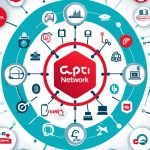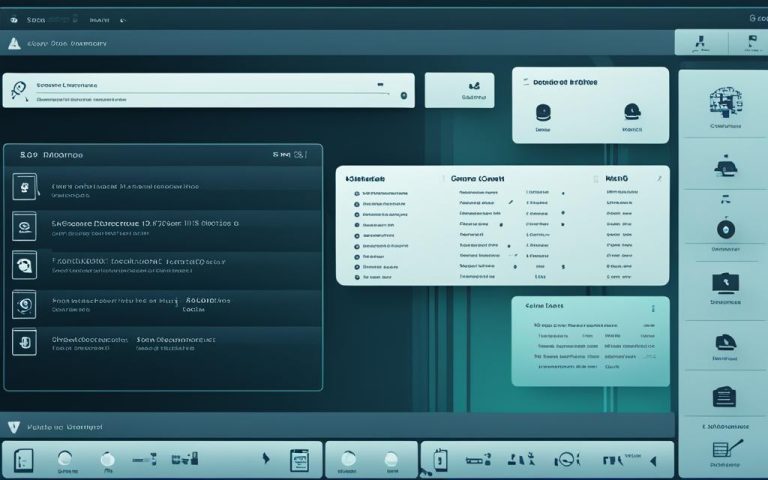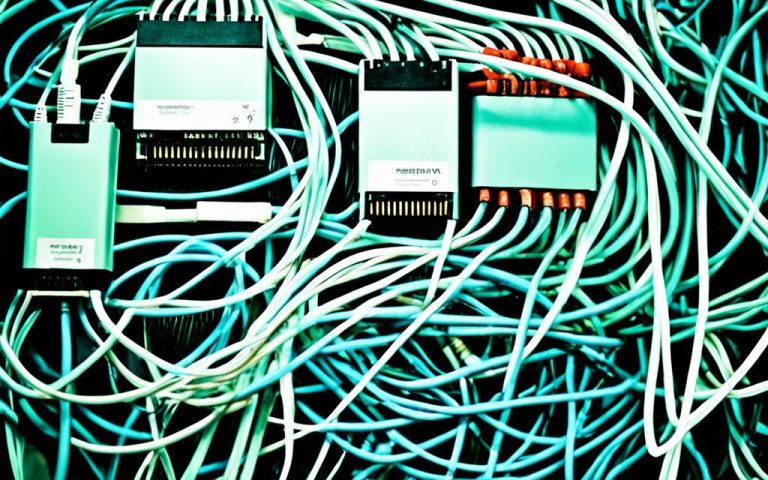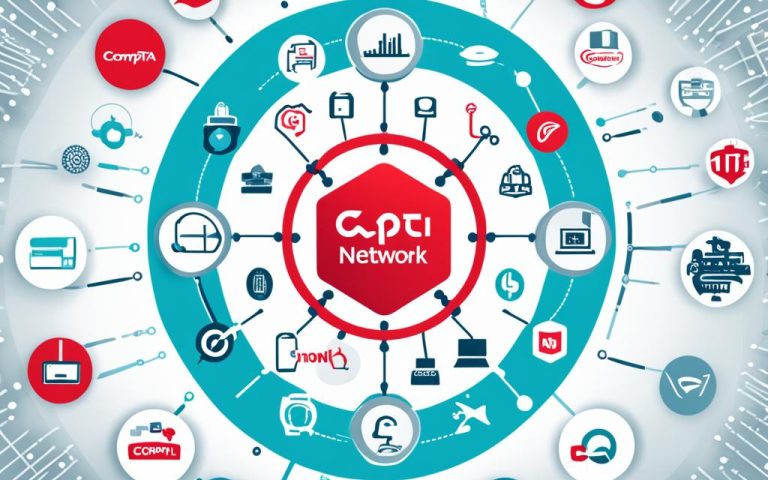As a network administrator, you’re key to measuring how bits move in a network. You keep an eye on data packets to make sure everything runs smoothly. This helps you spot and fix problems that slow down the network1.
Key Takeaways
- Measuring bit transfer is a crucial responsibility of network administrators.
- Monitoring and analyzing data packets helps ensure optimal network performance.
- Accurate measurement of bit transfer helps identify and address issues affecting network performance.
- Network administrators play a vital role in maintaining efficient network operations.
- Measuring bit transfer helps optimize network performance and minimize disruptions.
Understanding Knowledge Transfer
Knowledge transfer is key to an organization’s success. It helps share skills and info among team members. This sharing boosts innovation, productivity, and keeps a competitive edge in today’s fast-changing business world. By sharing knowledge and best practices, teams can use everyone’s skills to grow and stay strong.
Many companies struggle to share knowledge before key employees leave, which slows down info sharing2. It’s important to set clear goals for sharing knowledge to avoid duplication and frustration2. Sharing knowledge is more than just preparing for when someone leaves; it’s about building a team that works well together and knows a lot2.
Knowledge comes in two types: explicit and tacit. Explicit knowledge is easy to write down and share. Tacit knowledge is more personal, based on experiences and gut feelings. Getting and sharing tacit knowledge is harder but very important2.
A good plan for sharing knowledge has steps like finding key knowledge holders, saving important info, sharing it, and checking how well it was shared2. Companies use many ways to share knowledge, like mentoring, learning together, and online courses2.
Sharing knowledge helps the whole organization do better. It creates a team that works together well, keeps learning, and can adapt to new challenges. Sharing knowledge helps employees grow, makes better decisions, and builds a strong team ready for the future.
“Knowledge is the lifeblood of any organization. In today’s rapidly evolving landscape, the ability to transfer knowledge efficiently and effectively is a key factor in driving growth and staying competitive.”
Importance of Knowledge Sharing
Sharing knowledge is vital for success. It makes teams work better together, speeds up new ideas, and solves problems faster. When people share what they know, they create a smarter team that makes better choices and solves problems better. It also keeps the team learning and improving, keeping up with new trends and ideas.
Sharing knowledge also uses everyone’s different views and experiences. This makes a team more creative and innovative. It helps the team quickly adapt to new changes and find new chances to grow.
Sharing knowledge is also good for employees. When people have lots of knowledge to learn from, they feel important and supported. This makes them happier and more involved at work. Employees who learn from sharing knowledge can grow their skills, take on new tasks, and help the organization succeed.
Types of Knowledge in Knowledge Transfer
Knowledge transfer covers two main types: explicit knowledge and tacit knowledge. Explicit knowledge is easy to share and learn through writing or speaking. You can get it by reading or doing online research.
Tacit knowledge is harder to share. It comes from personal experiences, observations, and insights. To share this type, you need to use methods like mentorship, guided experience, or work shadowing.
Research shows that 51% of what employees know at work comes from their experience3. This shows how important practical learning and tacit knowledge are in sharing knowledge.
| Type of Knowledge | Description |
|---|---|
| Explicit Knowledge | Easily shared through writing or speaking. Gained through reading or online research. |
| Tacit Knowledge | Based on personal experiences and insights. Hard to share without methods like mentorship or work shadowing. |
Knowing the difference between explicit and tacit knowledge is key to good knowledge transfer. Using both types helps organizations share information and keep learning and improving.
Explicit knowledge is the base for sharing knowledge well. It gives a clear way to share information. Tacit knowledge adds depth and context, helping people use their unique insights and experiences to solve problems and make decisions.
References:
- A report says 51% of what employees know at work comes from their experience.
The Process of Knowledge Transfer
The process of knowledge transfer has several steps to make sure knowledge moves well within an organization. A structured plan helps keep valuable insights safe and makes sure they help both people and teams.
First, we need to spot the knowledge we want to capture. This means finding people who know a lot or have special skills. By doing this, we can make sure their knowledge helps everyone else. (knowledge capture)4
Once we know what knowledge we need, we can capture it. We use interviews, writing it down, or technology to do this. The aim is to make the knowledge easy to find and use for others. (knowledge capture)4
Then, we share and transfer this knowledge. We use different ways like mentoring, learning by doing, or working with others. These methods help move knowledge from experts to those who want to learn. (knowledge sharing)4
It’s also key to check how well we’re sharing knowledge. By using metrics and evaluations, we can see what’s working and what’s not. This helps us make our knowledge sharing better. (knowledge transfer plan)4
In the end, knowledge transfer is about finding, capturing, sharing, and checking how well we’re doing it. Doing it well helps everyone in the organization learn and grow. This makes the whole organization work better.
| Knowledge Transfer Steps | Key Statistics4 |
|---|---|
| Identify knowledge | TCP and UDP are the most popular transport protocols available on top of IP. |
| Capture knowledge | Multiplexing and demultiplexing are two key responsibilities of the transport layer. |
| Share and transfer knowledge | UDP has an eight-byte header compared to TCP’s 20-byte header, leading to smaller packets on the network. |
| Measure and evaluate effectiveness | The UDP checksum is a 16-bit value used for error-detection and is computed over the UDP header, application data, and a pseudo IP header. |
Measuring Training Effectiveness
It’s crucial to check how well training programs work. This helps see how they improve employees’ skills, knowledge, and performance5. Using training evaluation metrics helps track and see if training is successful6.
These metrics give clear numbers that show how well training works6. They look at things like scores, pass rates, how happy employees are, and how much they finish the training6.
For example, scores show how much employees remember after training6. Pass rates tell us how many employees meet the training goals6.
Also, seeing how happy employees are with the training helps us know if it’s good for them6. Knowing who finishes the training shows how engaged they are6.
Learning dropout rates show who stops the training early6. This tells us if the training keeps employees interested and motivated6.
Finally, checking how well new skills work in the job shows the real impact of training6. This tells us how training affects employees’ work performance over time6.
By checking training effectiveness often, organizations can find ways to get better6. This helps them make smart choices and use resources well to improve their training6.
Training Evaluation Metrics Example:
| Metric | Description |
|---|---|
| Scoring | Measure the level of knowledge retention and mastery |
| Pass or Fail Rates | Assess the proportion of employees meeting defined criteria |
| Training Experience Satisfaction | Gauge the perception and satisfaction of employees |
| Training Completion Rate | Measure the engagement and commitment of employees |
| Learning Dropout Rate | Evaluate the number of employees who discontinue training |
| Post-Training Performance | Assess the practical application of skills in the workplace |
Using training evaluation metrics gives organizations key insights into their training6. By making smart choices based on these metrics, organizations can keep improving their training6.
The Importance of Measuring Training Effectiveness
It’s key for companies to check how well their training works. This helps them see if their money spent on teaching staff is paying off. By looking at how well training does its job, companies can see if they’re getting the results they want.
Checking how well training works also helps see how it helps employees. Training that makes employees better can make them happier, work faster, and feel more secure in their jobs. It also lets companies find out what’s holding them back from reaching their goals. This info helps them make better plans to improve.
There are many ways to see how well training works. One way is by looking at how well networks perform. Things like how fast data moves, how reliable it is, and how much data is lost can tell a lot about the quality of training.
Training on security is also very important. The GS104 guide from CDSE talks about how important it is to teach people about security. It says that knowing about security helps stop bad things from happening. Training on keeping information safe is a big part of this.
Understanding how networks work is also key to seeing how well training works. Things like how fast data moves, how much gets lost, and how much data can be sent at once are important. By keeping an eye on these things, companies can make sure their training is delivered well.
| Measurable Elements | Description |
|---|---|
| Bandwidth | The amount of data that can be transferred in a given time period, typically measured in bits per second (bps). |
| Latency | The delay between sending and receiving data over a network, typically measured in milliseconds (ms). |
| Jitter | The variation in latency over time. |
| Packet Loss | The percentage of data packets lost or corrupted during transmission over a network. |
| Throughput | The actual amount of data successfully transferred over a network in a specified time period. |
| Availability | The percentage of time the network is operational and accessible. |
| Downtime | The amount of time the network is not operational or accessible. |
| Mean Time Between Failures (MTBF) | The average time the network operates without failures. |
| Mean Time to Repair (MTTR) | The average time it takes to restore the network after a failure. |
| Round-Trip Time (RTT) | The time taken for data to travel from source to destination. |
| Quality of Service (QoS) | Assessment of adherence to predefined service level agreements and performance standards. |
| Error Rates | Evaluation of errors, re-transmissions, or collisions during data transmission. |
| Baseline Measurements | Foundational measurements required to assess network and application performance. |
By using both network performance checks and security training, companies can make their training better. This way, they can help their employees get better, reach their goals, and do their best work.
Evaluation Methods for Measuring Training Effectiveness
Organizations use various methods to check how well training works. The Kirkpatrick model and the Learning-transfer evaluation model are two key methods.
The Kirkpatrick model was created by Dr. Donald Kirkpatrick. It has four levels to check training programs:
- Reaction: This checks how happy participants are with the training. It shows if the training was relevant and useful.
- Learning: This looks at how much knowledge and skills participants gained. It sees if the training met its goals and spots areas needing more work.
- Behavior: This level sees if the learning is used at work. It checks how well participants use their new skills and knowledge on the job.
- Results: The last level looks at how the training affects the company. It measures if the training led to better productivity, performance, or customer happiness.
Another method is the Learning-transfer evaluation model. It focuses on how well learning moves from training to real work. It checks if participants can use their new knowledge and skills at work.
Using these methods, companies can learn how effective their training is. They can see how it affects satisfaction, knowledge, job skills, and company results. This helps them make their training better and grow.
Reference:7
Locating Tests for Measuring Intangible Benefits
Measuring the benefits of training, like changes in attitudes or behaviors, requires the right tests. The PsychTests database is a great place to find these tests. But, it might not be available everywhere. Google Scholar through the library can also help by giving access to full-text articles with test questions or instruments. By searching for specific topics and adding terms like “instrument,” “measure,” or “validation,” you can find research that includes tests for intangible benefits. It’s key to know what you want to measure and look through various studies for the right tests8.
To see how training affects intangible outcomes, we need valid and reliable tests. These tests help measure changes in how employees feel, think, and act after training. The PsychTests database has many tests that are scientifically proven to measure different psychological traits. By using this database, you can find tests made and tested for measuring intangible outcomes. But, remember, not all libraries have access to it8.
If you can’t use the PsychTests database, try Google Scholar through your library. Google Scholar has lots of scholarly articles, some with tests for measuring intangible benefits. Use keywords like “instrument,” “measure,” or “validation” to find articles with tests. This way, you can access full-text articles even if you can’t get to special databases8.
When using Google Scholar, be clear about what you want to measure. Different things need different tests. For example, if you’re looking to improve communication skills, find tests that measure that. Look through research studies and article methods sections to find tests that fit your needs8.
When picking tests, make sure they’re validated and reliable. Valid tests give accurate results you can trust. Also, think about where and why you’re testing. Choose tests that fit your population and training goals. By picking the right tests, you can really see how your training affects people8.
Benefits of Measuring Training Effectiveness
Measuring how well training works has many perks for companies. It shows if the money spent on training is worth it9. It also helps see how training helps employees grow and perform better9. Plus, it helps match training with company goals, showing where it helps and where it doesn’t9. This way, companies can make smart choices and keep improving their training.
One big plus of checking how well training works is seeing its return on investment (ROI). By looking at how training affects workers, companies can see if it’s making a difference9. This helps decide where to put resources next and focus on the best training.
Checking how well training works also helps with employee growth. By seeing what training achieves, companies can spot where employees need more skills or knowledge9. This is key for planning better training that meets employee needs.
Also, measuring training effectiveness helps keep it in line with company goals9. It shows if training is helping reach goals like happier customers, better operations, or better products. This makes sure training supports the company’s success.
What companies learn from measuring training helps them make their training better9. They can spot where training needs work and focus on improving. This means training is more effective and helps both employees and the company.
In short, checking how well training works gives companies important info. It helps them make smart choices, use training resources well, and keep improving their training9. By linking training with company goals and checking its ROI, companies can boost employee skills, productivity, and success.
Challenges and Considerations in Measuring Training Effectiveness
It’s key for organizations to check how well their training works. This helps them see what’s working and what’s not. But, it’s not easy. They need to think about collecting data, making sure it matches their goals, and measuring things you can’t see.
Data Collection
Getting good data is a big challenge. Trainees and others must help out. It’s important to use strong methods to collect data. This makes sure the data shows how well the training is doing.
Reference:7
Aligning Metrics
Choosing the right metrics is also tough. They must match the training’s goals. This way, organizations can see if their training is working. They can then make smart choices for the future.
Reference:10
Capturing Intangible Outcomes
Some training effects are hard to measure. Things like attitudes or behaviors are tricky. Organizations need to find special ways to measure these things. This gives a full picture of the training’s impact.
Measuring training success is hard but doable. By focusing on data, setting clear goals, and measuring the unseen, organizations can learn a lot. This helps them improve their training for the future.
Summary of Challenges and Considerations
| Challenges | Considerations |
|---|---|
| Data Collection | Ensure accurate and reliable data collection methods |
| Aligning Metrics | Select metrics that align with training goals and objectives |
| Capturing Intangible Outcomes | Utilize qualitative approaches and specialized instruments |
Continuous Improvement and Future Training Initiatives
Measuring how well training works gives us valuable feedback. This feedback helps us improve our training for the future. By looking at the results of our training checks and what we’ve learned lessons learned12, we can make our training better. We can update our training to better fit what employees need and match our business goals.
It’s key to get input from everyone involved in the process. This makes sure our training is effective and meets the needs of our employees. By always making our training better, we create a place where learning and growth are valued. This helps our employees grow and succeed12.
Conclusion
A network administrator’s job is key to making sure networks work well. They use tools like OWAMP and the ping command to check how fast data moves. This helps find any slow spots (NetBeez)13. They also look at packet loss and jitter to keep the network running smoothly.
For training, it’s important to see if it’s working. By checking how well training works, groups can make it better. They use tools like Start-BitsTransfer and System.Net.HttpWebRequest to see how long it takes to download files (Microsoft DevBlogs)14. This helps them find the best way to share training.
There are many tools and devices to measure how bits move. LXI devices make it easy to share data between devices. They move data quickly and efficiently (LXI Consortium)15. Companies like Agilent and National Instruments help connect with these devices easily.
FAQ
What is the role of a network administrator?
Network administrators make sure data moves smoothly within a network. They keep an eye on data flow and fix any issues that slow things down.
What is knowledge transfer and why is it important?
Knowledge transfer means sharing important knowledge from experts with others. It helps new employees get up to speed faster and keeps important skills alive for the future.
What are the types of knowledge in knowledge transfer?
There are two kinds of knowledge: explicit and tacit. Explicit knowledge is easy to share through writing or talking. Tacit knowledge comes from personal experiences and insights.
What is the process of knowledge transfer?
First, identify the knowledge you want to share. Then, capture it through interviews or documents. Finally, share it through mentorship or hands-on experience.
How can training effectiveness be measured?
You can measure training effectiveness by looking at scores, pass rates, and how happy trainees are. Also, check how many complete training and how well they do after.
Why is measuring training effectiveness important?
It shows if training is worth it and helps improve employee skills and performance. It also points out where training can be better.
What evaluation methods can be used to measure training effectiveness?
Use methods like the Kirkpatrick model or the Learning-transfer evaluation model. They look at how satisfied trainees are, if they learned new things, and if they apply what they learned.
How can tests for measuring intangible benefits be located?
Find tests in places like the PsychTests database. Use terms like “instrument” or “validation” when searching for research studies and articles.
What are the benefits of measuring training effectiveness?
It shows the value of training, helps track employee growth, and finds areas to improve and align with business goals.
What challenges and considerations are there in measuring training effectiveness?
It can be hard to get accurate data and make sure metrics match training goals. You might need to use special methods to measure things that can’t be easily counted.
How can continuous improvement be achieved in future training initiatives?
Improve training by looking at how well it worked, learning from past experiences, and getting feedback. Update training to meet the needs of employees and the business.
Source Links
- https://www.firewall.cx/networking/network-fundamentals/network-performance-testing.html – Test Network Throughput, Delay-Latency, Jitter, Transfer Speeds, Packet loss & Reliability. Packet Generation Using Iperf / Jperf
- https://maestrolearning.com/blogs/how-to-effectively-complete-a-knowledge-transfer-plan/ – How to Effectively Complete a Knowledge Transfer Plan | Maestro
- https://www.n-ix.com/effective-knowledge-transfer-plan-move-it-outsourcing-new-vendor/ – Effective knowledge transfer plan: moving IT outsourcing projects to a new vendor
- https://people.cs.rutgers.edu/~pxk/352/exam/study-guide-2.html – CS 352 Exam 2 Study Guide
- https://www.geeksforgeeks.org/performance-of-a-network – Performance of a Network – GeeksforGeeks
- https://www.techtarget.com/searchnetworking/definition/bandwidth – What is network bandwidth and how is it measured?
- https://www.geeksforgeeks.org/performance-of-a-network/ – Performance of a Network – GeeksforGeeks
- https://osp.gatech.edu/faq – FAQ | Office of Sponsored Programs
- https://www.techtarget.com/searchnetworking/definition/network-performance-monitoring – What is Network Performance Monitoring (NPM)?
- https://www.netc.navy.mil/Portals/46/NETC/inst/15402C.pdf?ver=Jp7ffzaooWhXjgiwTz4abg== – Quality of Content Block
- https://scialert.net/fulltext/?doi=itj.2011.927.943 – A Measurement Framework for Knowledge Transfer in E-Learning Environment
- https://www.smartsheet.com/content/operational-excellence – Key Principles of Operational Excellence | Smartsheet
- https://netbeez.net/blog/network-performance-analysis/ – Network Performance Analysis: A Deep Dive
- https://devblogs.microsoft.com/powershell-community/measuring-download-time/ – Measuring average download time
- https://lxistandard.org/Documents/Articles/Introducing LXI to a Network Administrator_final.pdf – PDF



















